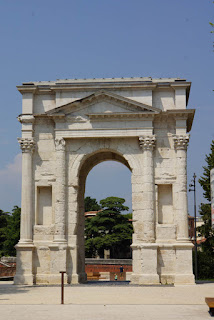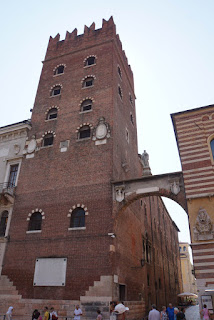Lovely, lovely Verona, Day 3. Breakfast at Flego, of course, and then we took a long and muggy walk outside the center, past this ol' castle...
...called Castelvecchio (which actually means "old castle" in Italian, heh)...
...to the church of San Zeno. Yes, ok, I know, I'm obsessed with visiting old churches, but they're so pretty! And full of art and fantastical architecture! And packed to the gills with history--a combination which, as we all know, I simply cannot resist!
Just look at it. Gorgeous and so old. Most of it dates to the 12th century, of course, as that pesky earthquake caused quite a bit of damage here, as well. (Interesting tidbit: that rose window is called the "Wheel of Fortune." I kid you not.)
Detail of that amazing polychrome over the porch entrance (1138).
The ship's-keel ceiling and current wall height were achieved in the late 14th century. Interestingly enough, the crypt here is open to the main sanctuary, and you can see its entrance above, in the center of the nave (it's those three dark arches, which are over the staircase leading down to it).
Behind the main facade are these massive bronze doors, which were assembled from other doors made by several unknown artists over (mainly) the 12th century.
Wall of frescoes dating back to the 12th through 14th centuries. In several places, you can see pieces of even older frescoes showing through.
Down in the crypt, which took its present form during the 12th and 13th centuries, when the original 10th-century crypt was "rearranged". (Sounds complicated, considering this is underneath the main church.) The remains of Saint Zeno, 8th bishop of Verona, are down here. (He died in about 380 AD.)*
On our way back into the center, we passed Castelvecchio again. (Next time, we'll visit its museum; not only is the place a medieval castle--built by the Scala family, of course--but it's rumored to be positively packed with ancient paintings and sculptures, as well as jewels and arms. Yes, please.)
Immediately next door is the Gavi arch, a bit of 1st-century Roman architecture whose history is far more interesting than its actual structure. It was destroyed under orders from Napoleon--the French found that it blocked traffic, and dumped its pieces at the Roman amphitheater--and rebuilt next to the Castelvecchio under orders from Mussolini, in a bid to bolster the legitimacy of the Fascist government by invoking the traditions and might of the Roman empire.
Castelvecchio and the Gavi arch just happen to lie at one end of the action-packed Corso Cavour, which is lined with palaces (such as the one above) and ends at the Borsari gate (which you may recall from such posts as this one).
Passing back by the amphitheater, we got to see the set-swapping crane in action. We were hoping to see it pick up something amazing, like the gigantic arm above, but no such luck. Boooooo.
Passed this gem of a building, too. Don't kid yourself: Verona is loaded with absolutely marvelous architecture.
I'd had zero plans to make this almost entirely a church-visiting trip, but we'd purchased a combo ticket that first day, and so what are you going to do? Our final stop was the church of San Fermo, and holy cow, what a way to finish things off. The current form of the church was created between 1261 and 1350.
Just check out the shape of that ceiling. Incredible.
If you take a slightly closer look, you can see the zillions of little arches up there...
...all of which have someone's face in them. Apparently, there are 416 saints painted on this ceiling.
Nifty model of the construction of said fantastical ceiling.
The main sanctuary was quite beautiful, and rather unusual, I thought.
Check out this amazing red marble Gothic pulpit from 1396...
...and these incredible 14th-century frescoes over the main altar!
And then we found the lower church. Which looks like this, and was built between 1065 and 1143. (Yes, I know, there are manmade things in existence that are considerably older than this, but still. THIS IS OLD. And in spectacular shape.)
The lower church is absolutely covered in frescoes from the 12th through 16th centuries. Those six-petaled flowers on the ceiling were painted by the Benedictines during construction in the 12th century, but the patterns were only rediscovered in 2005.
There are sixty-eight frescoes, to be precise, although some of them have been lost due to the recurrent flooding of the Adige river.**
Perhaps even more remarkable is that some pieces of the original paleo-Christian church--that is, the one built here in the 5th or 6th century--still survive in the Benedictine lower church. At least, that's what all of the signage said...but I have no idea to what they were referring. I'll just assume they were correct, and that I was unobservant. Yaaaaaay for ancient history!!
Ahem. Post-San Fermo, we stopped for a snack in it shadow, at the welcoming little Bar Fermo. (I ate the healthiest thing I've ever had in Italy there--this crazy-but-delicious concoction of 5 different grains, 4 types of beans, and 3 types of seeds, topped with grana padano and a little tuna. Stop for a bite, if you're in the neighborhood.) Then, as we were essentially done for the day and ready for a little AC***, we made our way back to the hotel.
But first, we made a point to wander past Porta Leona, a remnant of a Roman city gate built and refurbished between about 50 BC and 70 AD (and a counterpart to Porta Borsari).
Foundation of original lookout tower next to Porta Leona.
Just around the corner from our hotel, we ducked into this intriguing little wine store which had caught Mike's attention from the very first. The proprietor, Oreste, an incredibly outgoing and quite elderly Italian man who spoke zero English, gave us a tremendous welcome and kept pouring samples of Prosecco for us. Oreste is quite proud of the fact that his place is mentioned in the Rick Steves travel guides, and has photos of himself with Mr. Steves to prove it.****)
In retrospect, I absolutely and unequivocally should have bought this sweatshirt.
After cooling down for an hour or two (yes, we watched some TV off of Mike's laptop in our room that afternoon, and I'm not ashamed because it was so ridiculously hot), we headed off to Osteria il Bertoldo for a little dinner. What a cozy, quiet little place, tucked away from all the tourist noise...and what food. Their specialty is seafood, which seems a little strange in landlocked Verona, but when you think about it, in Italy, you're never more than a few hours' drive from the sea. Obviously, then, I had to start with their antipasto plate of lemony octopus salad, anchovies baked with bread crumbs, and whole salt-and-pepper shrimp, with three wee little herby hush puppy-type croquettes; and Mike went for a ridiculously tasty white bean, sausage, and clam soup. Next, I had a plate of chopped eggplant with smoked mozzarella and tiny datterini tomatoes with basil, all served up in a bowl made of crispy Parmigiano (yesssssss), and Mike had a baked risotto with sausage, smoked mozzarella, and zucchini. We split a plate of grilled fassone veal sliced onto a pile of baby arugula with more datterini and Parmigiano on top, and then it was onto dessert: the delizia al limone, which turned out to be a limoncello-soaked cake topped with limoncello custard, then with a heavy lemon-infused cream, and finally, with unsweetened whipped cream on top. (Um. Just writing this makes me want to go back, right now.)
After dinner, we roamed the streets for a bit...
...and then called it a night. Caught our last breakfast at Flego (sigh...), complete with one final round of mini-pastries:
...and then pointed our rental car north, towards home. As usual, what should have been a five-hour drive was more like seven, given tunnel traffic and abundant construction zones, but at least the scenery was beautiful.
And castle-y.
Two thumbs way, way up, Verona. We loved you and we'll be back.
What we're watching: How to Get Away with Murder, and holy crap. I think this is one of the few shows on TV that's not entirely predictable, which I love about it. Fair warning, there's a good bit of skin--and, obviously, murder--on it, but it's riveting. And we've started in on The Good Wife, which is ridiculously, ridiculously compelling. There are some good shows out there right now, people! It's refreshing. Also been indulging in a bit of rugby, as the World Cup is being played right now in England. I know their chances aren't great, seeing how strong Australia and New Zealand are, but hey...they're my people, so GO, SCOTLAND!!
Next up: a good bit of cheese, and the cows come home. (Again.) Which two things, oddly enough, are in no way related--at least, for our purposes here. See you next time.
*Crazily enough, in 2012, to commemorate the 1650th anniversary of Saint Zeno's ordination (as if that's not an arbitrary number!), the local bishop had Saint Zeno's body disinterred for some rather extensive study, research, and stabilization, and then took him on a tour just about everywhere throughout the province and city of Verona in a glass coffin. In October 2013, the body and relics were even visited by the Pope.
**And just in case you're wondering, yes, it is possible for me to get ancient-church fatigue, in a similar manner to that in which I get museumed out: after a point, one has seen perhaps too much amazing art and architecture within a small amount of time, and ceases to be properly moved by it. Not to worry, though: the recovery period is usually very, very short. (On to the next!)
***That's "air conditioning," for my European readers. I know, I know, it's sehr American, but you, too, might enjoy it when it's 40 degrees and 80 percent humidity outside.
****Upon revisiting his website today, it appears as though Oreste has retired since we were there, and is putting his shop up for sale. I feel genuinely fortunate to have stumbled in there on a whim--what a wonderful experience we had with him! (And yes, we did come home with some wine. How could you doubt?)

















































































